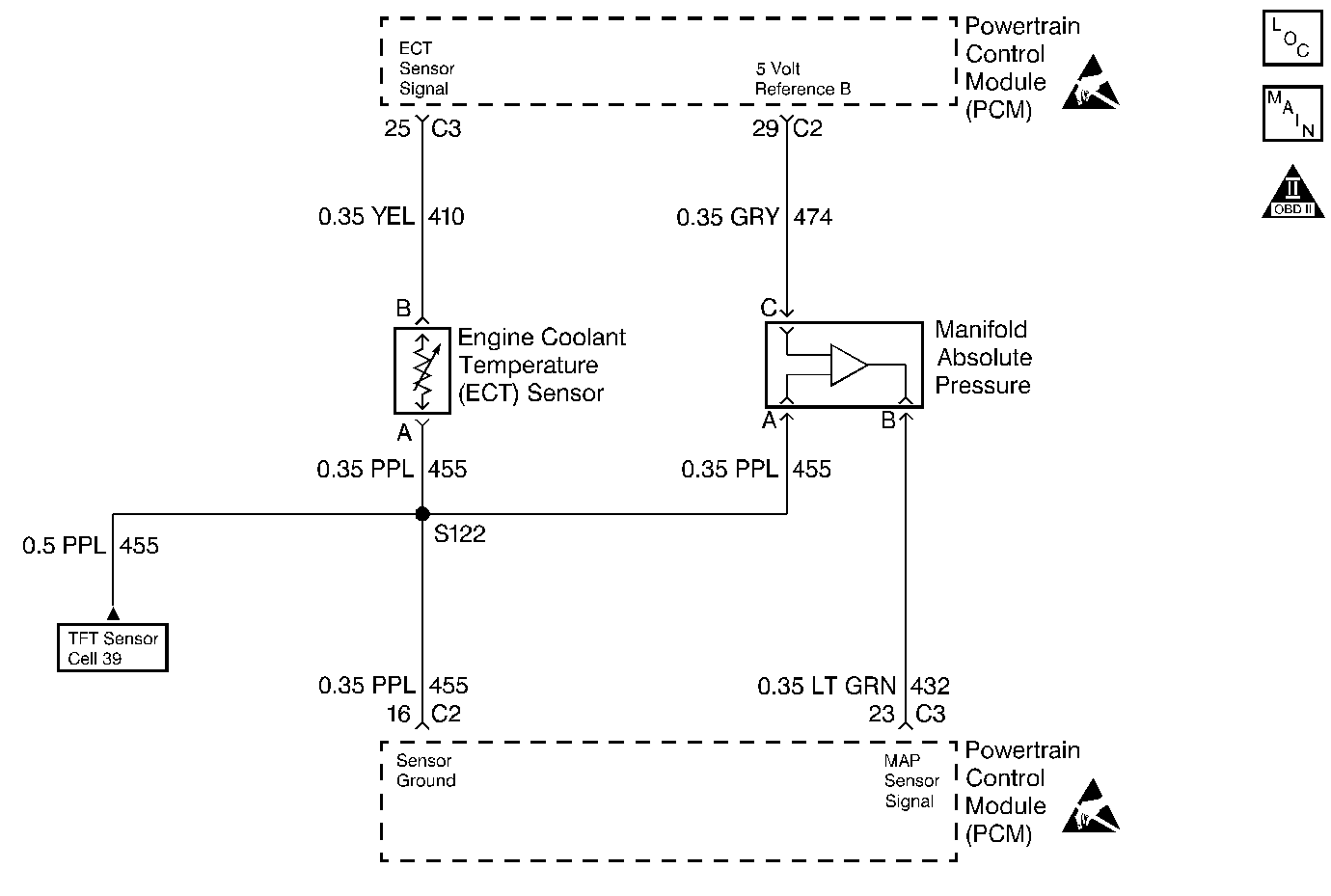
Circuit Description
The Manifold Absolute Pressure (MAP) sensor is mounted to the top of the intake manifold. The MAP sensor measures pressure changes within the intake manifold which are an indication of engine load. The MAP sensor has a 5.0 volt reference, a ground and a signal circuit.
The MAP sensor contains a diaphragm which changes resistance based on pressure. When manifold pressure is low (high vacuum) sensor output voltage is low. When manifold pressure is high (low vacuum) sensor output voltage is high.
MAP sensor voltage (depending on altitude) can range from 1.0-1.5 volts at idle (high vacuum) to 4.0 - 4.9 volts at wide open throttle (low vacuum).
When the PCM senses a signal voltage lower than the normal operating range of the sensor, this DTC will set.
Conditions for Setting the DTC
| • | No TP sensor DTCs set. |
| • | MAP less than 0.24 volts. |
| • | All conditions are met for 0.3 second. |
Action Taken When the DTC Sets
| • | The DTC will be stored in the PCM memory when the diagnostic runs and fails. |
| • | The Malfunction Indicator Lamp (MIL) will not illuminate. |
| • | The PCM will record operating conditions at the time the diagnostic fails. This information will be stored in Failure Records. |
Conditions for Clearing the MIL/DTC
| • | A history DTC will clear after 40 consecutive warm-up cycles, if no failures are reported by this or any other non-emission related diagnostic. |
| • | A last test failed (Current DTC) will clear when the diagnostic runs and does not fail. |
| • | PCM battery voltage is interrupted. |
| • | Using a scan tool. |
Diagnostic Aids
An intermittent DTC can be caused by electromagnetic interference (EMI). Inspect related circuits for being too close to secondary ignition wires and the alternator.
For intermittents, refer to Symptoms .
Test Description
Number(s) below refer to step numbers on the diagnostic table.
Step | Action | Value(s) | Yes | No | ||||||||
|---|---|---|---|---|---|---|---|---|---|---|---|---|
1 | Was the Powertrain On-Board Diagnostic (OBD) System Check performed? | -- | ||||||||||
Is the MAP value affected by moving the harness or connectors? | -- | |||||||||||
3 | With the ignition ON, engine OFF. Is the MAP sensor reading greater than the value shown? | 85 kPa | ||||||||||
4 |
Did the MAP value change smoothly through the entire range of the test without any erratic readings? | -- | ||||||||||
5 | With 20 inch Hg vacuum applied to the MAP sensor, is the MAP sensor reading the same or less than the value shown? | 34 kPa | ||||||||||
6 | Disconnect the vacuum source from the MAP sensor. Does the MAP sensor reading return to its original value? | -- | ||||||||||
7 |
Does the scan tool indicate that this diagnostic failed this ignition? | -- | Go to Diagnostic Aids | |||||||||
8 |
Was a problem found and corrected? | -- | ||||||||||
9 | Check for a plugged or leaking vacuum supply to the MAP sensor. Was a problem found and corrected? | -- | ||||||||||
10 | Check for the following conditions and repair as necessary:
Is the action complete? | -- | -- | |||||||||
11 | Replace the MAP sensor. Is the action complete? | -- | -- | |||||||||
12 | Check the connections at the PCM. Was a problem found and corrected? | -- | ||||||||||
13 |
Important:: Replacement PCM must be programmed. Refer to Powertrain Control Module Replacement/Programming . Replace the PCM. Is the action complete? | -- | -- | |||||||||
14 |
Does the scan tool indicate that this test ran and passed? | -- | ||||||||||
15 | Using the scan tool, select Capture Info, Review Info. Are any DTCs displayed that have not been diagnosed? | -- | Go to the applicable DTC table | System OK |
